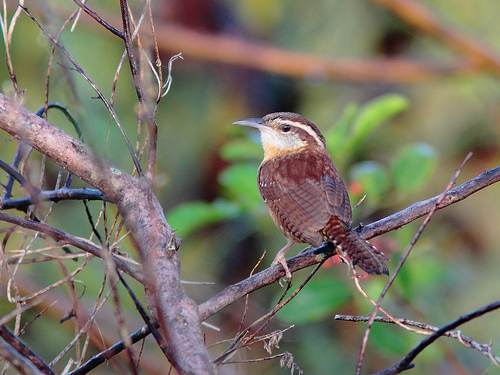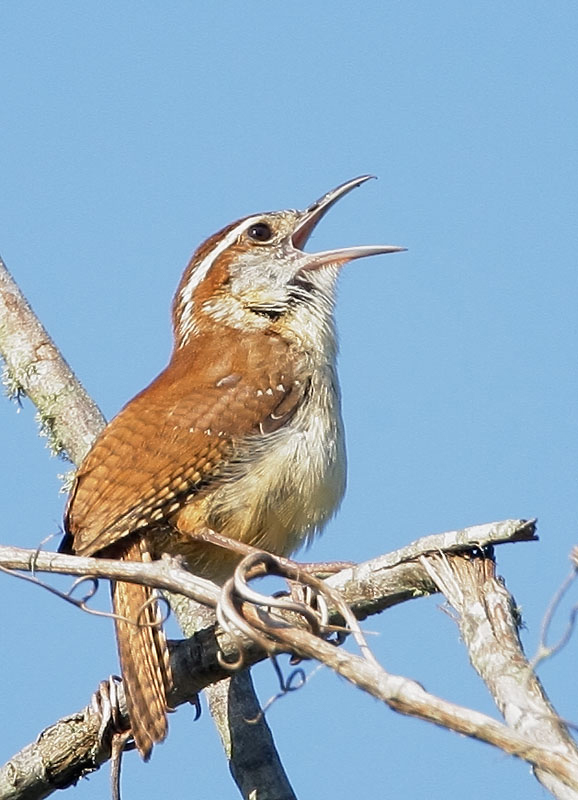BirdNote® How Birds Sing So Loud
Air Date: Week of April 12, 2013

Carolina Wren on a branch (photograph: Ken C Schneider)
Evolution has given the Carolina Wren one of the most impressive songs in the forest. BIRDNOTE®’s Michael Stein explains how this tiny bird can sing so loud.
Transcript
[Written by Bob Sundstrom]
CURWOOD: Evolution is a wonderful thing - creating the most weirdly beautiful, ingenious and unlikely creatures. In the beautiful camp there are, of course, many, many birds. But don’t look for showy feathers or glorious colors to distinguish the subject of today's BirdNote®. Here's Michael Stein to explain.
[CAROLINA WREN SONG]
STEIN: When a Carolina Wren tips back its head and sings, something remarkable happens. A Carolina Wren can sing so loudly that you almost have to shout to be heard over its song.
Wrens aren’t the only small birds with big voices, but they are the best known for this ability. How can a bird like a Carolina Wren, all of five-and-a-half inches long and weighing only as much as four nickels, produce so much sound?

The Carolina Wren has one of the loudest songs out there (photograph: Ken C Schneider)
The answer lies in the songbird’s vocal anatomy. Unlike you and I, who create sound from the larynx way up at the top of our windpipe, a bird’s song comes from deep within its body. Birds produce song in a structure called the syrinx, located at the bottom of the windpipe where the bronchial tubes diverge to the lungs. The syrinx is surrounded by an air sac, and the combination works like a resonating chamber to maintain or amplify sound.
Evolution has given birds a far more elaborate sound mechanism than it’s given humans. Where we wound up with a flute, songbirds got bagpipes.
I’m Michael Stein.
[MUSIC: Brad Mehldau “The Falcon Will Fly Again” from Highway Rider (Nonesuch Records 2012)]
[CUTAWAY MUSIC: Joe Sample: “Cannery Row” from Carmel (UMG Records 1979)]
[MUSIC: Brad Mehldau “The Falcon Will Fly Again” from Highway Rider (Nonesuch Records 2012)]
[CUTAWAY MUSIC: Joe Sample: “Cannery Row” from Carmel (UMG Records 1979)]
CURWOOD: To see some photos of those shrill Carolina Wrens singing their hearts out, flit on over to our website LOE.org.
[Bird songs for BirdNote come from The Macaulay Library at the Cornell Lab of Ornithology. Today’s show brought to you by The Bobolink Foundation. For BirdNote, I’m Michael Stein.
###
Bird sounds provided by The Macaulay Library of Natural Sounds at the Cornell Lab of Ornithology, Ithaca, New York. Carolina Wren song [128927] recorded by Gerrit Vyn.
BirdNote's theme music was composed and played by Nancy Rumbel and John Kessler.
Producer: John Kessler
Executive Producer: Chris Peterson
© 2013 Tune In to Nature.org April 2013 Narrator: Michael Stein
ID#
sound-17-2013-04-11 sound-17}
Links
Living on Earth wants to hear from you!
Living on Earth
62 Calef Highway, Suite 212
Lee, NH 03861
Telephone: 617-287-4121
E-mail: comments@loe.org
Newsletter [Click here]
Donate to Living on Earth!
Living on Earth is an independent media program and relies entirely on contributions from listeners and institutions supporting public service. Please donate now to preserve an independent environmental voice.
NewsletterLiving on Earth offers a weekly delivery of the show's rundown to your mailbox. Sign up for our newsletter today!
 Sailors For The Sea: Be the change you want to sea.
Sailors For The Sea: Be the change you want to sea.
 The Grantham Foundation for the Protection of the Environment: Committed to protecting and improving the health of the global environment.
The Grantham Foundation for the Protection of the Environment: Committed to protecting and improving the health of the global environment.
 Contribute to Living on Earth and receive, as our gift to you, an archival print of one of Mark Seth Lender's extraordinary wildlife photographs. Follow the link to see Mark's current collection of photographs.
Contribute to Living on Earth and receive, as our gift to you, an archival print of one of Mark Seth Lender's extraordinary wildlife photographs. Follow the link to see Mark's current collection of photographs.
 Buy a signed copy of Mark Seth Lender's book Smeagull the Seagull & support Living on Earth
Buy a signed copy of Mark Seth Lender's book Smeagull the Seagull & support Living on Earth

